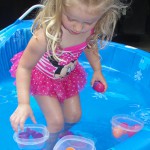by Monica Brinkley | Jun 2, 2014

Simple sorting games teach pre-math skills to young children.
Children are born curious and are constantly learning about the world around them. Children learn basic math skills through daily activities and interaction. They practice basic math skills as they notice differences between things, how events happen the same way every time, and how they can make events happen. Many parents push their children to count to ten, but teaching children to count involves more than reciting. It involves helping children understand the meaning of numbers.
Children will learn the meaning of numbers when they are developmentally ready. They might know the numbers in sequence, but are not able to use them to count. In others words, they may count to three and move four objects. Begin counting with children around the age of two to three. This helps children begin to move towards matching one thing at a time with the numbers as they say it.
Three- to four-year-old children are still learning to understand quantity. They usually can count to five and are growing in their understanding of what numbers really mean. By ages four to six, they are counting with meaning, usually matching the numbers one to ten with ten items.
Counting can be fun with your help. There are many fun activities you can do with your children to assist in learning the meaning of counting. Count socks as you sort them; count the juice boxes in the refrigerator or the cars going by. The more experience they are given, the more they will learn the meaning of numbers. Giving your child experience regularly will help them in their understanding of numbers.
To help your child get ready for math, give him/her opportunities to think about patterns and to sort things. Use items you find around the house or outside. Lay out a pattern with items such as a leaf, stick and stone and repeat the pattern. Ask your child to make the same pattern. This is a very simple but fun way to introduce math concepts. Sorting can be done easily when doing household chores. Sorting towels by color, putting small towels in this spot on the shelf and large towels in that spot are just a couple of sorting ideas.
Learning about shapes, space, and measurement are also pre-math skills you can help preschool children develop. Talk about shapes as you are walking or riding down the road. Examples: see the round stop light; this sandwich is square until we cut it in half, it then becomes a triangle. Inches, feet, and other units of measurement don’t make much sense to a young child. However, you can teach a child to measure with objects like a shoe. Have them see how long a rug is with a shoe. Then work up to giving them a ruler to work on measurement problems.
Teaching pre-math skills is easy. Recognize the curiosity in young children and use this as an opportunity to teach in a fun way.
Source: Penn State Extension; Better Kid Care, Math for Every Age.
by Heidi Copeland | May 12, 2014
 Not much has changed since the American Academy of Pediatrics released their clinical report in 2006 about the importance of play in promoting healthy child development. In fact, play is so important to optimal child development that in 1989 the United Nations High Commission for Human Rights recognized play as a right of every child. Seriously! Play is essential to child development. Play contributes to the cognitive, physical, social, and emotional well-being of children and youth.
Not much has changed since the American Academy of Pediatrics released their clinical report in 2006 about the importance of play in promoting healthy child development. In fact, play is so important to optimal child development that in 1989 the United Nations High Commission for Human Rights recognized play as a right of every child. Seriously! Play is essential to child development. Play contributes to the cognitive, physical, social, and emotional well-being of children and youth.
Play is a child’s work. Play is how a child learns best. Play is the most effective way to involve every aspect of child development – cognitive, physical, social, and emotional well-being of children and youth. Play allows children to engage and interact in the world around them. Play enhances children’s learning readiness, learning behaviors, and problem-solving skills. Play is a simple joy that we should all remember as a cherished part of childhood.
Nonetheless, children and youth are experiencing decreased amount of child-directed, free unstructured play.
As another school year comes to an ends start thinking about the importance of this free, unstructured, child-driven play this summer. Are you allowing enough time in each day for your child to be running, bike riding, bouncing balls, climbing, and gazing up at the clouds actively using their imagination? Or are they going to be sitting and passively entertained through the screens of a television, computer, video game or even phone?
Think about it, play is a tried-and-true part of child rearing. Play also offers a perfect opportunity for parents to get fully involved with their children and youth.
Don’t buy into the next thingamajig that promises to make your child, better, brighter, happier, or more successful. Buy into the tried, trusted and traditional methods of play! The only thing you have to invest is quality time with your children and youth.
As the clinical report also mentions, adults who share unscheduled, spontaneous playtime with their children are being wonderfully supportive, nurturing and productive. What do you have to lose? Make some time to play today!
by Ginny Hinton | Jun 5, 2013

The proper seat correctly installed helps keep children safe.
Dawson is a healthy, active 3-year-old whose mom makes sure he eats right, learns something new every day, and rides safely in the car. Until a few months ago, Dawson, who weighs 42 pounds and is 42 inches tall, traveled in a booster seat. When his mom learned that, because of his age, Dawson would be safer in a 5-point harness, she moved him to a safer car seat and made sure it was installed correctly. Just a few weeks ago, Dawson was riding in the car with relatives when someone drove in front of them and caused a 45 mph crash, totaling both cars. One of the adults fractured her collarbone; another suffered a concussion. Dawson bit his tongue and was really scared – but he was unhurt. Dawson’s mom says she is truly thankful she put him in the correct car seat. Because car seats are made to survive only one crash, she has already replaced his old seat and Dawson continues to travel safely in the car.
Dawson’s story can happen to any child. It’s important that every parent know how to keep their children safe on the roads. Here are some quick pointers to keep children safe at every age:
- All infants and toddlers should ride in a Rear-Facing Car Seat until they are 2 years old or until they reach the highest weight/height allowed by the manufacturer. Rear-facing is the safest way to travel!
- Children 2 years to at least 4 years old and 40 pounds should use a Forward-Facing Car Seat with a harness for as long as possible. Keeping a child who weighs more than 40 pounds in a harness is the safest practice, as long as the seat’s weight limits are followed.
- Children whose weight or height is above the forward-facing limit for their car seat should use a Belt-Positioning Booster Seat until the vehicle seat belt fits properly, typically when they are at least 4 feet 9 inches tall and are between 8 and 12 years old. Children using a booster seat should be able to sit reasonably still for an entire trip.
- Children who are old enough and large enough to use the vehicle seat belt alone should always use both Lap and Shoulder Belts for the best protection. Children younger than 13 years should sit in the back seat.
Certified Child Passenger Safety Technicians (CPSTs) are trained to help caregivers make sure their children are traveling safely. Find a CPST near you at http://cert.safekids.org.
by Monica Brinkley | Apr 23, 2013
Se lf-control is an important skill for all children to learn. In other words, individuals know right from wrong or have power to control their own actions. Self-control is the ability to think before you act, rather than being controlled by your feelings. Children who rely on parents or other children to make choices for them do not learn self-control.
lf-control is an important skill for all children to learn. In other words, individuals know right from wrong or have power to control their own actions. Self-control is the ability to think before you act, rather than being controlled by your feelings. Children who rely on parents or other children to make choices for them do not learn self-control.
Often times, these children may follow others’ bad choices and not take responsibility for the consequences of their behavior. When the child is young, this causes many frustrations. As they grow, the problems can grow as well and the consequences can become more and more serious, even leading to self-destructive behavior like the use of drugs and alcohol. Therefore, it is very important to start young to build the skills that children will need later in life.
Self-control lessons start in the first year of life, but it is never too late to help a child build more self-control. Research shows that when you respond predictably to an infant who cries, later on that baby is likely to cry less rather than more. So you need to get to know your baby’s style of soothing.
Toddlerhood is a demanding time for parent and child. Many toddlers become frustrated because they may have trouble making themselves understood or may be too little to do the things they want to do. Expect toddlers to have little self-control.
Children behave best by keeping them on a regular schedule as much as possible. Help them get enough rest and serve regular meals and snacks. At this age, children are very distractible – you can redirect them to another activity when they are doing something unsafe. If your child has a temper tantrum, make sure they are safe and keep them from hurting themselves or others. After the tantrum is over, they need comfort and support. Teach some basic words, such as NO and STOP, to use in difficult situations. The goal of self-control at this age is to help children begin to use words to express themselves.
During the preschool years, children are eager to play with others their own age, but it is rarely smooth. The goal of this stage of development is to learn how to talk about a problem and solve it with words rather than aggressions. Encourage children to say what the problem is and ask them to come up with ideas for a solution. As long as all the children involved agree, let them try out their own solutions.
This is the time to introduce family chores. Simple jobs like setting the table and putting away laundry are good for children at this age. Research has found that children who have regular chores from the age of four are more successful in early adulthood.
The work of helping your child build self-control continues through the elementary school years and into the teen years. Children learn to be responsible by handling homework, family chores, and obligations to friends and family. Starting early and carrying on self-control lessons throughout your child’s developing years is the best way to give the gift of healthy self-control.




